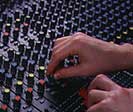| Author
|
mix balance: RMS vs Peak
|
metalball

Started Topics :
7
Posts :
40
Posted : Aug 7, 2007 17:10
|
hi everyone,
i need some help to figure something out.
while mixing a track which fully loaded with many different types of sounds, it gets pretty hard to balance the volumes without reaching quickly the clipping area, or the opposite, some sounds dissapear at the background under other sounds,
but while listening to artists like parasense (especially Love to Hate), it seems they've managed pushing many different sounds into the dynamic area, and it sound damn good.
so, i've figured out that the RMS of the sound may effect the so called "strength" of the sound within the track.
so how did it happen? i had a kick loaded on a channel, with a EQ in the insert. while monitoring the channel with PAZ Freq., i was playing a bit with the low freq of the kick, between 45-20 Hz, and then i saw that the RMS bar jumped up for about 8-+ db, while the Peak bar didn't move almost!
is there any truth in my discovery? does the RMS power of the sound makes it louder inside the mix while its Peak stays at normal db's?
is there a way to gain RMS power to sound?
thnx.
        134-139 bpm 134-139 bpm |

|
|
Tomos
IsraTrance Full Member

Started Topics :
84
Posts :
981
Posted : Aug 7, 2007 17:55
|
If you're clipping while mixing, turn everything down and start again lower. If the level jumps when 2 sounds play at once, try inverting the phase of one of the sounds, eqing a 'hole' in it or pan to another location.
After mastering sounds may appear more solid, but try and get the best mix you can before even considering how mastering may improve it.
Not sure about your PAZ thing.. but if you've got a sampled kick then don't bother with the subs, I can never hear what I'm doing on my monitors in that range, theres a lot of low power down there and a small increase may account for the jump in volume. |

|
|
astrotec

Started Topics :
7
Posts :
193
Posted : Aug 7, 2007 18:11
|
i don't think you've discovered anything new here.
it is common knowledge that we percept averages more than peaks.
the higher the rms simply means louder sound, its basic shit man.
and there is a number of ways to add rms to a mix: drive, saturation, compression, maximizing etc. |

|
|
orange
Fat Data

Started Topics :
154
Posts :
3918
Posted : Aug 7, 2007 18:46
|
Quote:
|
On 2007-08-07 18:11, astrotec wrote:
i don't think you've discovered anything new here.
it is common knowledge that we percept averages more than peaks.
the higher the rms simply means louder sound, its basic shit man.
and there is a number of ways to add rms to a mix: drive, saturation, compression, maximizing etc.
|
|
its new for him.. not everybody knows the "basic shit"
orange
        http://www.landmark-recordings.com/ http://www.landmark-recordings.com/
http://soundcloud.com/kymamusic |

|
|
metalball

Started Topics :
7
Posts :
40
Posted : Aug 7, 2007 19:41
|
Quote:
|
On 2007-08-07 17:55, Tomos wrote:
If you're clipping while mixing, turn everything down and start again lower. If the level jumps when 2 sounds play at once, try inverting the phase of one of the sounds, eqing a 'hole' in it or pan to another location.
After mastering sounds may appear more solid, but try and get the best mix you can before even considering how mastering may improve it.
Not sure about your PAZ thing.. but if you've got a sampled kick then don't bother with the subs, I can never hear what I'm doing on my monitors in that range, theres a lot of low power down there and a small increase may account for the jump in volume.
|
|
well, first of all changing channels phase actually a great idea and i'll try that...
i really dont use any compressors/limiters until my mix stands at -2 db tops!
i dont bother with these lows at 20-40 hz,
and some times i either cut them either low them down, it's just the RMS vs Peak change i saw playing there...
the PAZ monitor exist for the freq. u can't hear, i watch the behavior of the wave/mix at the low end with it.
Quote:
|
i don't think you've discovered anything new here.
it is common knowledge that we percept averages more than peaks.
the higher the rms simply means louder sound, its basic shit man.
and there is a number of ways to add rms to a mix: drive, saturation, compression, maximizing etc.
|
|
well, i really didnt know that before, never studied anywhere or something, and no one ever passed me this common knowlege. and if someone did that, i wouldn't been asking this question.
actually, my question was it there a way to gain RMS for sample with minimum changing of the sample, i mean saturation/distortion pretty changing the whole sample...
i meant if there is some transperent way to gain RMS.
thnx.
        134-139 bpm 134-139 bpm |

|
|
snowflake

Started Topics :
9
Posts :
194
Posted : Aug 7, 2007 20:25
|
Quote:
|
On 2007-08-07 18:11, astrotec wrote:
compression, maximizing etc.
|
|
how's that for an answer...
        Out Here We're Stoned.... Out Here We're Stoned.... |

|
|
shachar
Basic

Started Topics :
13
Posts :
402
Posted : Aug 8, 2007 10:57
|
work on individual sound`s dynamic range.
when your parts are tighter and more compressed you can lower their gain but they will still be heard in the whole mix |

|
|
RenderingRebel
IsraTrance Junior Member

Started Topics :
23
Posts :
293
Posted : Aug 8, 2007 19:04
|
While mixing i dont care so much about the master clipping
If im satisfied with the whole mix i just select all the faders and bring em down till my master is about -2 or something
        SQL: http://www.myspace.com/sqlmusic SQL: http://www.myspace.com/sqlmusic
Coming up: Releases
Planned: make tracks |

|
|
metalball

Started Topics :
7
Posts :
40
Posted : Aug 9, 2007 00:52
|
Quote:
|
While mixing i dont care so much about the master clipping
If im satisfied with the whole mix i just select all the faders and bring em down till my master is about -2 or something
|
|
yea, but it sound like shit while mixing, no? i mean thats not the real sound while clipping...
Quote:
|
work on individual sound`s dynamic range.
when your parts are tighter and more compressed you can lower their gain but they will still be heard in the whole mix
|
|
ok so it's basically as the suggestion as working while clipping, and thats really doesnt sound right...
whats the meaning of "when your parts are tighter and more compressed"?
you mean like route all the sounds into one channel with comp at insert?
that sounds as a good idea for the final stages of the track, while compressing/limiting while the mix almost ready, cause working with comp/limiter on the master channel while mixing will solve the clipping problem but the sound is not true sound...
now, i would like to ask this question:
how much influence does the RMS factor has within the dynamic range, and how much the Peak?
whats the difference between those two? how they been measured?
i mean, both measured at dB units, but where the RMS taken from and where the Peak taken from?
thx.
        134-139 bpm 134-139 bpm |

|
|
Freeflow
IsraTrance Full Member

Started Topics :
60
Posts :
3709
Posted : Aug 9, 2007 01:32
|
some clipps dont have to mean distortion.
tighter is what it gets when you compress something with lots of peaks so you can increase the over all volume, the gain. sometimes you have to eq, compress, eq, compress to get the sound you want.
sometimes getting too involved with terminology and technology wont solve the real question/problem.
i think you notice that pro mixed and masterd tracks sound way higher and clearer than your own, its beacuse the artist has worked more with the individual sounds and not just strapp a limiter on the master to get a higher volume.
sounds should have a purpose and if you think about their purpose you can shape them after that and really give each sounds their right proportion.
im no thech freak by any means so how Db and RMS and that stuff works isnt my game, but i would like to know more, but just knowing how they work dont mean that you can create good sounds 
Peace and love!
|

|
|
metalball

Started Topics :
7
Posts :
40
Posted : Aug 9, 2007 02:31
|
Quote:
|
On 2007-08-09 01:32, Freeflow wrote:
i think you notice that pro mixed and masterd tracks sound way higher and clearer than your own, its beacuse the artist has worked more with the individual sounds and not just strapp a limiter on the master to get a higher volume.
|
|
i never put any effect of any kind on the master channel before i finish mixing,
but "way clearer and higher then my own" is the exactly what i'm looking for...
maybe technical termins and stuff wont create a great piece of work, but it might help to get a better sound (quality, not beauty), know what i mean?
greets.
        134-139 bpm 134-139 bpm |

|
|
sy000321
IsraTrance Junior Member

Started Topics :
46
Posts :
1142
Posted : Aug 9, 2007 03:02
|
Quote:
|
how much influence does the RMS factor has within the dynamic range, and how much the Peak?
whats the difference between those two? how they been measured?
i mean, both measured at dB units, but where the RMS taken from and where the Peak taken from?
|
|
very quickly:
rms is the average loudness, peak is the instante loudness.
rms is achieved difently depending on how it is measured, but imagine that you have equal parts at 5dbs and 10dbs then you'll get 7,5dbs.
take a snare or cymbal sample as an example: the sample will have a loud attack (peak) and become quieter as it fades away. the rms is the average of the whole sample.
hope its clear now

joao
        roll a joint or STFU :) roll a joint or STFU :) |

|
|
metalball

Started Topics :
7
Posts :
40
Posted : Aug 9, 2007 03:33
|
Quote:
|
the rms is the average of the whole sample.
|
|
ok, it get pretty clear, except for one detail:
while playing from VSTi, how exactly the measure been taken, while there is no sample?
if its taken from the sound current flow, or even a virtual sample of a few sec/msec from that particular VSTi, it makes no sence with the numbers, cause lets say im playing a straight note of bass from Trilogy, length of full bar, without any pauses, simple saw bass, no envelope one the filter, none at the VCA as well, and still the RMS and the Peak measures show different numbers!??!?!
lets say for the example that the Peak bar shows -6 db while the RMS bar shows -12...
thnx.
        134-139 bpm 134-139 bpm |

|
|
Trip-
IsraTrance Team

Started Topics :
101
Posts :
3239
Posted : Aug 9, 2007 10:50
|
I would presume that only a sqaure wave (a form of a sine wave) would present an RMS value that is equal to the Peak.
metaball, a signal has different peaks over it's wavelength period. Peak shows only the highest peak of all those peaks, RMS will average them.
        Crackling universes dive into their own neverending crackle... Crackling universes dive into their own neverending crackle...
AgalactiA |

|
|
AvS

Started Topics :
9
Posts :
464
Posted : Aug 9, 2007 13:15
|
This is interresting.
Im sure it's not possible to have a sound/wave where the RMS and peak is equal.
Square waves are strange. In think its because in theory the "vertical line" is suppose to be 100% vertical but thats not possible. If it was then i would believe that the RMS and peak would be the same because the wave would peak all the time but the vertical line must have a slight slope so it cannot peak all the time.
The RMS would be pretty close to the peak value though. |

|
|
|